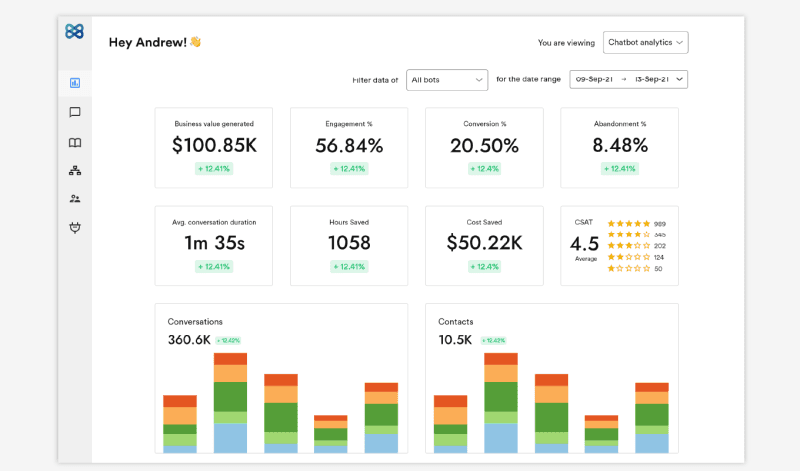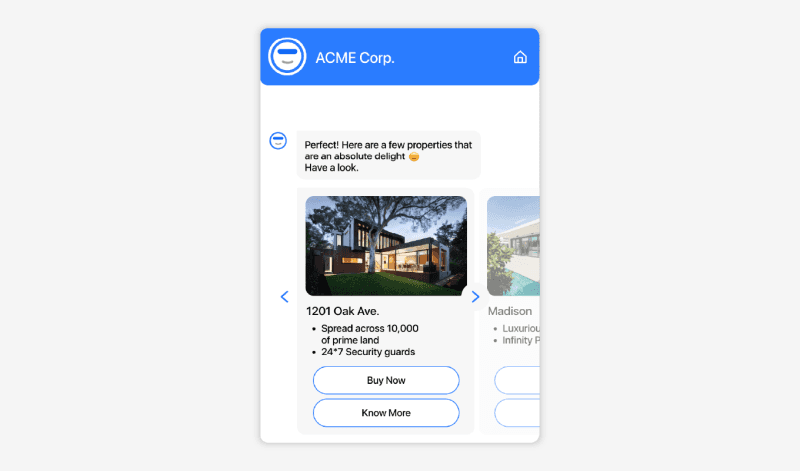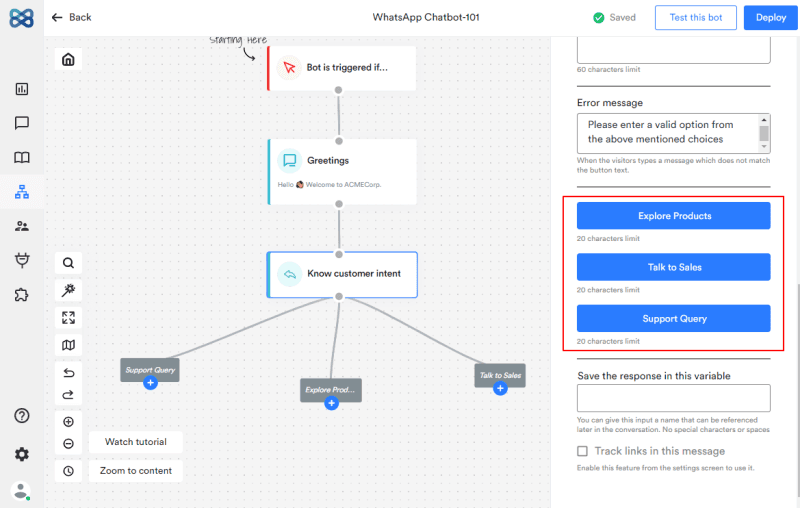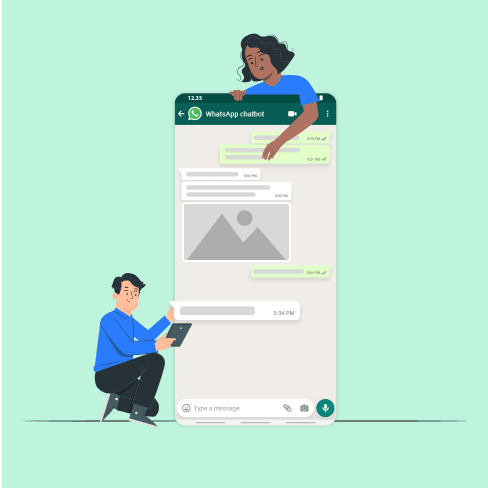Chatbot /
8 Min read
How to Build a WhatsApp Bot From Scratch in 2024 [No Code]
January 2, 2023

Bhavyadeep Sinh Rathod
Content Editor, WotNot
WhatsApp is no longer just your go-to chatting application. Over the years, it has become much more than that. The introduction of WhatsApp business APIs and WhatsApp bots has opened doors for small businesses and enterprises to use this highly popular chatting platform for their business.
And if you are someone looking to create a WhatsApp bot to boost their business, you have landed at the right place. Here, we will provide you with a detailed guide on how to create a WhatsApp bot from scratch. But before we dive into that, let’s have a look at what a WhatsApp bot is.
What is a WhatsApp Bot?
WhatsApp bots are automated software programs that use either rules or artificial intelligence (AI) to interact with humans through the WhatsApp chat interface. They enable communication with thousands of people simultaneously and provide automated replies that simulate a human conversation on WhatsApp. These chatbots operate on the WhatsApp platform using an API.
WhatsApp bots are on the rise, and there are many reasons why you should use one for your business.
Some of these reasons are:
WhatsApp has a massive amount of active users — 2 billion users across 180 countries
WhatsApp adds nearly 1 million new users every day
An average user spends around 3 hours on WhatsApp
46% female and 54% male user composition makes WhatsApp a genderly unbiased platform
WhatsApp has an open rate of 98% which is way higher than emails and SMSs
3 Stages of WhatsApp Bot Building
The entire WhatsApp bot building process can be divided into three stages:
Get a WhatsApp Business API
Choose a Platform
Create a WhatsApp Bot From Scratch
Let’s have a look in detail at all the stages one by one.
I. Get a WhatsApp Business API
WhatsApp Business API is a platform that facilitates businesses to communicate with their customers via automated messages. With this, businesses can send personalized messages, alerts, and updates to a huge number of people at once. In addition, they can also track delivery receipts and manage groups.
You can get WhatsApp Business API for your business via various WhatsApp Business API providers.
Some of the major WhatsApp Business API providers are:
Here, you can simply go to their webpage and fill in their form to get your WhatsApp Business API.
The process of getting a WhatsApp Business API can be quite confusing and chaotic. So, here we come with a video explaining you the entire process in detail.
There is also another way to get your WhatsApp Business API, and that is to get it directly from Meta. To know how to do it, watch this video.
Now, once you have the WhatsApp Business API, next you would like to test it out. Generally, the process of getting a WhatsApp Business API is quite lengthy. So, if you are looking to test your WhatsApp Business API instantly or you want to test it for your superiors and stakeholders, read this help article.
II. Choose a Platform
Once you have got the WhatsApp Business API, the next step is to choose a platform to build your WhatsApp chatbot. For this, you have to go through a few steps. Let’s discuss these steps in detail.
1. Define a Scope
Any project would be a catastrophe if its scope is not well-defined. The same goes for the WhatsApp chatbot too. A well-defined scope for your WhatsApp bot has a lot of benefits like:
Provides high-level clarity for you, your team members, and your stakeholders
Helps in time & cost management by identifying specific deliverables upfront
Identifying potential risks early on and enabling you to mitigate them
Helps in improving the quality of your WhatsApp bot by ensuring all the required elements are included
To define a detailed scope for your WhatsApp bot, you can ask yourself the below questions:
What are the business problems that your WhatsApp bot would address?
What does the expected process flow or user journey of your WhatsApp bot look like?
How will you calculate the ROI for your WhatsApp bot?
Who is your target audience?
What is your WhatsApp bot’s personality?
Your scope for the WhatsApp bot will be defined once you get the answer to all your questions.
2. List Down the Features Required
Once you have a clear roadmap in the form of a well-defined scope, next you have to list down all the features that you require in your WhatsApp chatbot. Here, you have to identify the features that help your WhatsApp bot to achieve success.
For example, if you are creating a WhatsApp chatbot for lead generation, then it should have the feature to capture information about the lead.
Similarly, if it is for an outbound campaign, it should have a carousel feature that shows the product in both text and image form.
Apart from these use case based features, there are some common features that your WhatsApp bot must have.
Let’s have a look at these features one by one.
a. No Code
If you are someone who doesn’t have the technical expertise then this feature becomes a must. No code WhatsApp bot builder feature helps you to create chatbot conversations without any coding.

All you have to do is create and drag & drop different action blocks on the visual interface.
b. Live Chat Handover
No matter how great your WhatsApp chatbot is, there will be times when it will falter due to complex inquiries. Secondly, a customer might want to connect with a human agent.

To ensure you do not lose out on customers in both scenarios, you need the live chat handover feature. This feature allows a human agent to take over the chat whenever any of the above scenarios arise.
c. Analytics Dashboard
An analytics dashboard presents stats, numbers, and patterns in such a way that it narrates the actual story of your business. This feature helps you to draw key business insights that help you to make data-driven decisions.

Some of the business KPIs that help you to visualize your business impact are below:
Business Value Generated
Hours Saved
Cost Saved
Hours Saved
CSAT
Average Conversation Duration
Engagement Percentage
Conversion Percentage
Abandonment Percentage
d. Rich Media Support
The main purpose of a WhatsApp chatbot is to have a human-like conversation with the users. And if you’re only using texts in your WhatsApp chatbot, you are missing a trick. It is because texts make the chatbot’s interface quite dull.

You can make your chat flow more interesting with rich media support where your chatbot can support:
GIFs
Images
Carousels
Buttons
Calendars
Videos
e. Choosing the Right Platform
Defining the scope and listing out the features will almost draw a picture of the platform that is suitable for your WhatsApp chatbot needs. Here, you must choose a platform that has all the required features and capability to translate your chatbot scope into reality.
Here is the list of best chatbot platforms that you can use for your WhatsApp bot.
III. Create a WhatsApp Bot From Scratch
There are many use cases for WhatsApp chatbot like WhatsApp customer service, outbound campaigns, lead generation, and many more.
For the sake of simplicity, here, we will use WotNot to create a lead generation WhatsApp bot for a company named ACME Corp that is into selling automobile parts. The main objective here is to collect details of prospective clients.
Let’s have a look at the various steps for building a lead generation WhatsApp bot on WotNot.
1. Add Your WhatsApp Number & API
First, you have to enter your WhatsApp number assuming that you have already procured your WhatsApp Business API. For this, you can click on the trigger action block and click on the “+Add” button beside the WhatsApp number section.

Once you click on it, a new window will open.
Here, you have to click on “WhatsApp Configuration” and enter details like:
Phone Number
WhatsApp Business API Provider

On selecting your API provider, you will be asked to enter your API ID. After entering all the details, you have to click on “Save” to add your WhatsApp number.
Once you have successfully saved your WhatsApp number, you have to go back and add your WhatsApp number in the section as shown in the first image.
2. Greet Your Customer
First things first, you have to greet your customer. Here, you must ensure that the greeting message is short and polite.

It should be crafted in such a way that it invokes a positive response from the user. Here, we will use the send message action block and add our greetings message.
3. Know Your Customer’s Intent
Here, you will try to know the intent of the customer and take the conversation forward. For this, you can provide users with multiple options. You can use the “reply” button to do the same. You can define your options as highlighted in the below image. Here, you must define your buttons wisely since WhatsApp only supports three buttons.

Here, we have added our three options which are:
Explore Products
Talk to Sales
Support Query
4. Understand the Requirement
Here, your aim should be to understand the requirement in great detail by collecting as much information as you can. For this, you can use the “collect input” action block.

Collecting these information would also help your sales rep to prep and increase the chances of converting the lead into the customer.
Below is the table that shows the key information that you should always collect.

Furthermore, you can keep an open box where the customer can write a description about their requirement.
If you want to restrict the user’s input, you can use the “options” or “list” action block. This ensures that the user will always have to click to choose the options defined by you.
5. Get Notified for Every Lead
Once the user gives all the details, you would like to get notified about the same. There are several ways to get notified about your leads. If you are a small company or a startup who doesn’t have the luxury of a CRM, you should use the “Send Email” option. With this, you get an email with all the details shared by the user.

If you are an enterprise or a big company that has a CRM, you can use our native integrations. We have native integration support for HubSpot, Zoho, Salesforce, etc.
In case, we don’t have a native integration for your CRM yet, you can make a direct HTTP request using their APIs for the same and create leads on your desired CRM.
6. Send a Thank You Message
You can end the conversation on a positive note by saying thank you to the user. For this, you can use the ‘send message” action block and draft the thank you message the way you want.

7. Test Your WhatsApp Bot
Once you complete the flow, it’s time to see how it looks.

Awesome! The WhatsApp chatbot works exactly how it was intended.
Conclusion
So, that was it! We created a lead generation WhatsApp bot from scratch and that too with extreme ease. This was mainly possible due to the easy to use interface and advanced bot building features of WotNot. You can also leverage WotNot’s WhatsApp bot builder to create outbound bots for multiple use cases.
So, what are you waiting for? Sign up with WotNot now for an easy, fast, and fun bot building experience. Create your first WhatsApp bot to automate and scale your business operations via the world's easiest bot building platform — WotNot and the world’s most popular app — WhatsApp.
For any assistance regarding WhatsApp bot building, you can contact our team or schedule a demo.
ABOUT AUTHOR
Bhavyadeep Sinh Rathod
Content Editor, WotNot
He likes technology, chatbots, comedy, philosophy, and sports. He often cracks hilarious jokes and lightens everyone's mood in the team.



